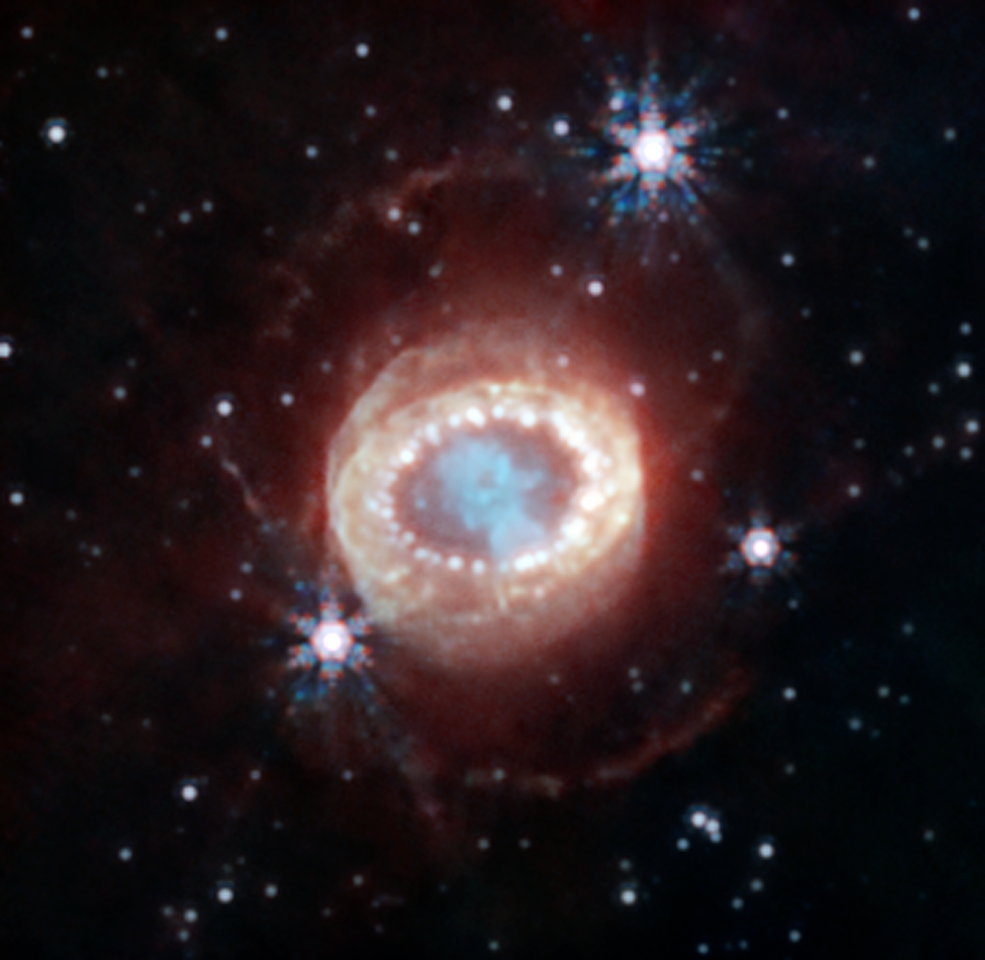James Webb Space Telescope of NASA has started to research one of the most well-known supernovae, SN 1987A (Supernova 1987A). Since its discovery in February of 1987, SN 1987A has been a focus of intense observations at wavelengths that range from gamma rays to radio for almost 40 years. It is situated 168,000 light-years farther in the Large Magellanic Cloud. New observations by Webb’s NIRCam (Near-Infrared Camera) offer a critical clue to the comprehension of how a supernova grows over time to shape its remnant.

Webb’s NIRCam (Near-Infrared Camera) captured this detailed image of SN 1987A (Supernova 1987A). At the center, material ejected from the supernova forms a keyhole shape. Just to its left and right are faint crescents newly discovered by Webb. Beyond them an equatorial ring, formed from material ejected tens of thousands of years before the supernova explosion, contains bright hot spots. Exterior to that is diffuse emission and two faint outer rings. In this image blue represents light at 1.5 microns (F150W), cyan 1.64 and 2.0 microns (F164N, F200W), yellow 3.23 microns (F323N), orange 4.05 microns (F405N), and red 4.44 microns (F444W). Image Credits: NASA, ESA, CSA, M. Matsuura (Cardiff University), R. Arendt (NASA’s Goddard Spaceflight Center & University of Maryland, Baltimore County), C. Fransson
This image reveals a central structure like a keyhole. This center is packed with clumpy gas and dust ejected by the supernova explosion. The dust is so dense that even near-infrared light that Webb detects can’t penetrate it, shaping the dark “hole” in the keyhole.
The inner keyhole is surrounded by a bright, equatorial ring—making a band around the waist that links two faint arms of hourglass-shaped outer rings. The equatorial ring, created from material ejected tens of thousands of years prior to the supernova explosion, consists of bright hot spots, which looked like the supernova’s shock wave hit the ring.
Currently, spots can be seen even outside the ring, with diffuse emission around it. These are the positions of supernova shocks that hit further exterior material.
Although these structures have been seen to varying degrees by Hubble and Spitzer Space Telescopes and Chandra X-ray Observatory of NASA, the unmatchable spatial resolution and sensitivity of Webb showed a new feature in this supernova remnant, which are small crescent-like structures. These crescents are believed to be a part of the outer layers of gas shot out from the supernova explosion.
Their brightness may be a sign of limb brightening, which is an optical phenomenon that is a consequence of viewing the growing material in three dimensions. Put differently, the viewing angle makes it seem that there is more material in these two crescents than there actually may be.
These images’ high resolution is also remarkable. Prior to Webb, the now-retired Spitzer telescope noticed this supernova in infrared during its complete lifespan, producing fundamental data about how its emissions developed over time. Nevertheless, it was never able to notice the supernova in such detail and clarity.
Since the supernova’s initial discovery, in spite of decades of research, there are multiple mysteries that remain, especially around the neutron star that should have been produced in the supernova explosion’s aftermath. As Spitzer, observation of supernova will be continued by Webb over time. Its MIRI (Mid-Infrared Instrument) and NIRSpec (Near-Infrared Spectrograph) instruments will provide astronomers the capacity to capture new, high-fidelity infrared data over time and achieve new knowledge about the recently found crescent structures.
In addition, Webb will continue to associate with Hubble, Chandra, and other observatories to offer new insights into the past and future of this renowned supernova.